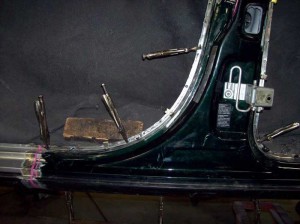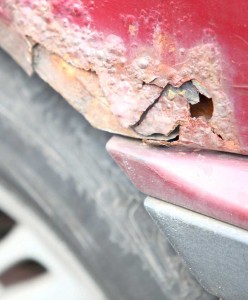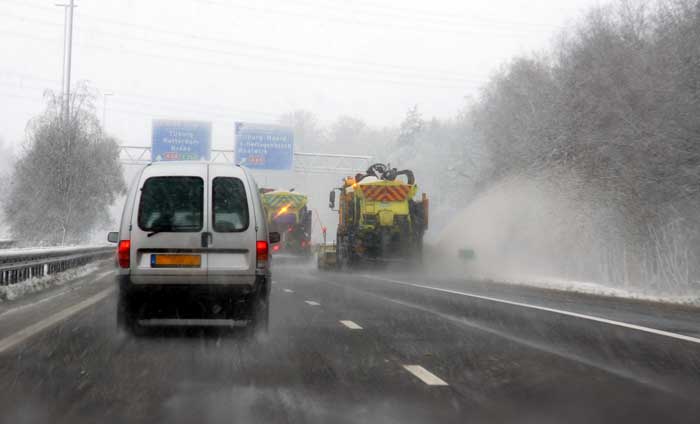Today’s metals are stronger than ever, but thinner, too. How long do you think it will take for corrosion to compromise metal strength once it takes hold – especially with the increasing use of liquid deicer to combat snow storms?
Look at your work from the inside and see what’s under there. Do you see the welds? Do you see foams and/or adhesives? Take a peek and see how much corrosion protection you have.
Living in Minnesota, you learn to deal with good and bad weather. The good is the beautiful, warm summers and beloved storms that bring hail and more business to the collision repair industry. The not-so-good, depending on your tolerance, is the cold winter, but that brings a steady flow of collision work from the ice and snow. But with that snow and ice comes methods of dealing with slippery conditions.
Pass the Salt
In the wintery states, we’re all familiar with sand and road salt. This means that along with increased business, we also get to deal with corrosion.
With the increasing use of road salt and chemicals to control ice conditions in the U.S., and the introduction of new chemicals in southern states, can you afford not to take a peek at your work from the inside?
In most vehicles, the factory corrosion protection is designed to give the vehicle long life. Car manufacturers have improved this protection over the years through much road testing, which has increased vehicle life dramatically. Remember when 100,000 miles was considered a lot for a car? If we were to buy a car today, we wouldn’t even flinch at that mileage. Most would say it has barely reached half its age. This began a trend that has owners hanging on to vehicles much longer than in the past – and has also increased the resale value of vehicles. I-CAR’s Corrosion Protection class (CPS01) is an excellent class to learn about the harsh conditions vehicles and your repairs will be subjected to.

How Long Will It Last?
This leads me to this question: How long will your repair last? A shop through all the best cycle time and best laid plans can be stopped dead in its tracks by comebacks, redos and the dreaded warranty.
Repair shops often do not get enough time to repair the vehicle right the first time. How much do you get paid for warranty? A simple quality control program can alleviate or prevent any work from leaving that may cause a warranty issue later on. I-CAR put together a class called Inspecting Repairs for Quality Control (QUA01) to help shops see and realize what to look for. But, we’re a prideful bunch and tell ourselves that we know what we’re looking for. The problem is, who’s looking? Nobody is perfect every time repairing a vehicle – just as no vehicle is perfect off the assembly line. But being consistent and catching the occasional “dangit” can prevent a repair from coming back – and eliminate unhappy customers.

Corrosion Protection
Corrosion protection is one of my sore spots on this issue. In the past, corrosion took time to show its ugly side. Steels were thick, and corrosion stayed on the surface longer. Today’s metals are stronger than ever, but thinner, too. How long do you think it would take to compromise the metal strength once corrosion takes hold? Could a vehicle’s integrity be compromised? A shop’s reputation can definitely be compromised. Preventing this type of problem is fairly straightforward.
❶ Maintain Your Equipment – Be sure your MAG, MIG and STRSW welders are running correctly and everyone knows how to use them. Attend a training class such as I-CAR’s Squeeze-Type Resistance Spot Welding (WCS04), which features in-shop demonstrations on proper STRSW. Many welds that fail are due to operator error – including operators not maintaining equipment.
❷ Use Recommended Corrosion Protection Procedures – Almost all vehicle manufacturers have recommendations on protecting vehicles. They’ve learned the hard way, and it has been proven to work. You’re paid to do it, so do it. Look up all OEM procedures and follow recommendations diligently. When STRSW is called for, use the spot welders. When you can’t access both sides, use MAG or MIG welding.
❸ Use Correct Primers – Some will disagree, but epoxy primers are invaluable in preventing corrosion. Unlike many self-etching primers, epoxy primers have excellent properties as barrier coats for corrosion protection. Car manufacturers have recommendations on epoxy primers and where to use them. Many of the new epoxy primers have much shorter top coat times than in the past, competing with the speed advantage of using self-etching primers. You can apply them by brushing, daubers and spraying, making them versatile for use anywhere in the shop.
An example of duplicating as close to OE as possible is to jam the interior parts with epoxy primer prior to welding. This gives all interior components as close to factory specs as possible. Most vehicle manufacturers require epoxy primer as a barrier coat to be used where glass adheres to vehicles. The urethanes and primers used by glass professionals that go over the top of epoxy primer are not barrier coats and cannot form barrier coats.
Although this is a different issue entirely, do not color coat or clearcoat pinch welds where adhesives for glass will bond unless recommended.
❹ Clean and Verify – Clean all application equipment. Before using, check that all tips and wands are spraying correctly. Verify coverage in vehicle.
❺ Inspect All Welds – Before the body fillers or seam sealers go on, check the welds. If you don’t know what porosity or heat affect zone is or don’t know what bad or good welds look like, take I-CAR classes WCS04, Steel GMA (MIG) Welding Theory (WCS06e) online, QUA01 and/or many of the other classes in the Steel Structural Technician role. Be sure to inspect the backsides where possible to verify penetration. I’ve met many people in the industry who do not know what a bad weld looks like.
❻ Finish the Weld – Be sure to clean the backside of all ash marks where possible and apply epoxy primer by either brush or dauber to the interior or backside of welds. Corrosion happens on both sides from the heat of the weld. In interior areas, be sure to apply wax-based protection and flood areas to seal out moisture.
❼ Weld Bonding – When recommended, do so. The adhesive does many things, corrosion being a major part. By not weld bonding, you’re forgoing a major corrosion prevention step. It’s not hard to apply and doesn’t take as long as technicians think once they’re used to it. The learning curve is fairly short, and the benefits of using on all new and used parts when recommended are overwhelming. With all the harsh environments your repairs will be exposed to, you need all the protection available.
Seeing the Big Picture
Although there are many more steps I can add, I think you see the big picture. Following these steps will give you longlasting and safe repairs on every job. None of this will work, however, unless you use quality control procedures through the whole repair and not just after the vehicle is painted. You must find anything that’s overlooked before it costs more time and money.
Simple tools to invest in would be a decent set of wands and tips for applying corrosion protection. It’s an additional cost, but they’ll be easier to use and maintain. A drywall camera or borescope would also be helpful to see in between panels and inside areas to verify welds and coatings. Well-maintained welders are a must.
Warranties and Reputation
When we see how long vehicles are going to be kept by the customer and the fact that some will be handed down to other family members, failure to properly protect these vehicles will cost a shop everything. States that may not have seen corrosion from road salt and chemicals in the past will soon learn the effects of these conveniences. The expense of warranties and the lost reputations can shut a shop down. So the question is, how long will your repair last? Can you afford not to take a peek?
Adapted from Mitch Becker’s article in BodyShop Business.















